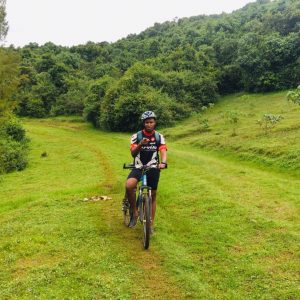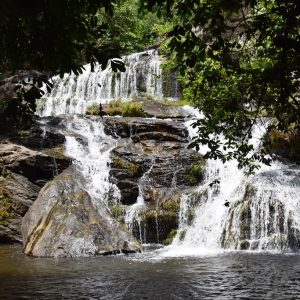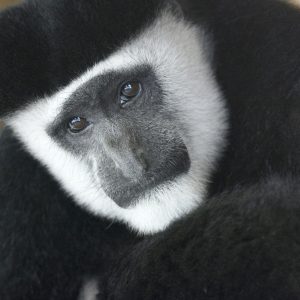4 Days Climb Mount Meru
- Fifth highest mountain on the African continent
- Fascinating panoramic views
- Tropical forest with moss-covered trees and wildlife
- Ideal acclimatization for the Kilimanjaro
- Guided Tour with overnight stay in huts
- Private guide, cook & porter team
Tour FAQs
- Overview
- Itinerary
- Circuit / Region
- Included Services
- Excluded Services
- Options
- Rates
- Best Time To Travel
- Packing Tips
- Notes
Mount Meru is a dormant stratovolcano located 70 kilometers (43 mi) west of Mt Kilimanjaro and is one of the most beautiful volcanoes in Africa. With a height of 4.562.13 meters (14,968 ft), it is the second highest mountain in Tanzania. Mt. Meru is a challenging trek due to its steepness, but it's a great way to acclimatize yourself before attempting Mt. Kilimanjaro or a great trekking option for those who want to take on a climbing challenge and get the sense of being out in the wild, but are not ready to tackle Mt. Kilimanjaro.
Along the crater rim there are wonderful views of the gigantic crater with its 1.500 m (4,921,26 ft) deep caldera walls. Mount Meru is the topographic heart of Arusha National Park. Its fertile slopes rise above the surrounding savanna and support a forest that hosts diverse wildlife, including nearly 400 species of birds.
- Day 1: Momella Gate 1.500 m (4,921,26 ft) – Miriakamba Hut 2.514 m (8.248,031 ft)
Distance covered: 6 km / 3.5mi
Approx. time taken: 4 – 5 hoursStart from Momella Gate in the late morning. Climbers are accompanied by an armed ranger, as there is abundance of wildlife on the lower slopes. The track soon takes you past some open grassland and offers some game viewing. You can see buffalo, warthog, elephant, etc. and then continue as a steady ascent through mountain forest. You can have your lunch at the famous “Fig tree”. After lunch we continue through less dense forests, where there are a lot of birds and monkeys including the black and white Colobus. By mid-afternoon, you have the first closer views of the towering cliffs and the Ash Cone. The Miriakamba Hut, situated in an idyllic grassy glade, is reached in time to enjoy the last afternoon sun and beautiful views over the surrounding plains towards Mt. Kilimanjaro. Ascent is 1.014 m (3,326,772 ft).
The huts are very comfortable with running water and bunk beds with mattresses and pillows.Meal plan: lunch, dinner
- Day 2: Miriakamba Hut 2.514 m (8,248,031 ft) – Saddle Hut 3.560 m (11,679,79 ft)
Distance covered: 6.5 km / 4mi
Approx. time taken: 3 – 4 hoursThe walk from Miriakamba Hut to the saddle below Little Meru is a short day but a steep, steady climb all the way. The path starts through attractive, open and lush mountain forest and continues beyond the halfway point of Elephant ridge uphill through the giant heather and other moorland vegetation to reach Saddle Hut for lunch. The afternoon is free to rest and enjoy the views. For energetic ones, can make the short climb of appr. one hour to the nearby summit of Little Meru (3.820 m/ 12,532,81 ft) for superb views just before sunset, then head back down to Saddle Hut. The Saddle Hut is similar to the Miriakamba Hut, but the water is collected from a stream about 10 minutes away.
Meal plan: breakfast, lunch, dinner
- Day 3: Saddle Hut 3.560 m (11,679,79 ft) – Summit “Socialist Point” 4.566 m (14980,31 ft) – Miriakamba Hut 2.514 m (8.248,031 ft)
Distance covered:19 km / 12mi
Approx. time taken: 10 - 12 hoursThe summit day starts between midnight and 2am depending on your guide’s assessment of your pace (they are trying to time it, so that you arrive at the summit at sunrise). First you climb steeply to Rhino Point (3.800 m / 12,467,19 ft). The path continues along an undulating ridge of ashes and rocks to reach Cobra Point (4.350 m/14271,65 ft). The views are stunning: the cliffs of the Crater rim, the ash cone rising from the crater floor, the Mt. Kilimanjaro floating on the morning clouds, and the Rift Valley if the weather is clear. The path to the summit of Socialist Pak is an hour more on a wonderful but often steep path. Occasionally, animals such as Klipspringers and mountain reedbucks can be seen over the rocky terrain. The route back to Rhino Point in the sharp morning light along a narrow ridge between the sloping outer wall of the crater and the sheer cliffs of the inner wall is one of the most dramatic and exhilarating walks in Africa. This trail has excellent views back towards the crater and over the plains of the National Park.
Meal plan: breakfast, lunch, dinner
- Day 4: Miriakamba Hut 2.514 m (8,248,031 ft) – Momella Gate 1.500 m (4,921,26 ft)
Distance covered: 6 km / 3.5 mi
Approx. time taken: 4 – 5 hoursAfter breakfast you will begin your final descent to Momella Gate. During your descent you will pass the mountain forest and open grassland with cape buffalos and warthogs. With a little luck, you can also see giraffes and elephants. Upon arrival at the Momella Gate, you will be picked up and taken to your hotel in Moshi or Arusha town.
Meal plan: breakfast
- Transport from and to your hotel/residence or airport/seaport
- Private English-speaking professional mountain guides
- Guides, porters, cook salaries
- Rescue fee
- Park fees
- All activities (unless labeled as optional)
- All accommodations (huts) as mentioned in the itinerary
- All meals while on the mountain incl. filtered water, tea and coffee
- Camping equipment (sleeping bag excluded)
- All Taxes/VAT
- International/national flights and visa fees
- Climbing gear
- Sleeping bag and personal items for the hike(please have a look at our packing list). Almost all equipment is available to rent from our team in Tanzania if required.
- Bath towels
- Additional accommodation before and at the end of the tour
- Tips for guide, assistant guide, cook and porters
- Personal items (souvenirs, travel insurance, Internet, laundry etc.)
- Soft and alcoholic Drinks
- Government-imposed increases in taxes and/or park entrance fees
- This tour can be shortened to 3 days with some changes in the itinerary
- Additional accommodation before and after the tour can be arranged for an extra cost
- Extension of stay or additional program is possible / or have a look at our other offers
- Mount Meru can be climbed all year round
- But the best time to climb this mountain is during the dry season, from June to early March.
- December to February are the months for the best views of Kilimanjaro.
Please follow the list below to ensure your comfort. You will have a better vacation if you are prepared.
But please note that this list is not exhaustive!
Almost all equipment is available to rent from our team in Tanzania if required. Please talk to us in advance for further planning.
During the climb to the summit of Mt. Meru the weather can range from warm and tropical at the base of the mountain to cold on the summit.
Cotton should be avoided as it is hydrophilic, which means it absorbs moisture and blocks breathability.
Since June 1, 2019, Tanzania has been banned from using single-use plastic bags. If you want to separate items in your bag, please use re-usable "packing cubes". Please also note that disposable plastic bottles are not permitted on Mount Meru.
Please note that your large backpack can weigh a maximum of 20 kg. This is the maximum permissible weight that a porter can carry. This weight limit is checked at the hotel pickup. To carry your most important belongings with you, a 20 - 40 l daypack is best. You should pack your backpack very carefully and not carry too much with you, because at altitude you need all the strength for your ascent.
Basic Equipment
- Daypack 30 – 40 L (for your personal belongings, you need to carry it yourself) + rain cover
- Duffle bag or backpack (60 – 80 L / maximum weight 20 kg/carried by the porter) + rain cover
- Sleeping bag (possible to hire from our team in Tanzania)
- 1x mat/sleeping pad – to protect from hard and cold underground (possible to hire from our team in Tanzania)
- Trekking poles
- Water bladder/bottles for 3 liters of water (please remember disposable plastic bottles are not permitted)
Clothes
Hands & Feet
- 1 x light gloves
- 1 x winter gloves (summit day)
- Waterproof Hiking boots (they should fit well, with lots of room for the toes, and are well worn in before starting the trek)
- Training shoes (for the camp)
- Outer socks, liner socks and one pair of thermal socks for summit day
- Gaiters (protection against the ingress of rubble and moisture / not particularly necessary)
Upper body and legs
- Fleece or softshell jacket
- Hard shell outer jacket (for protection against rain and wind)
- Poncho (recommended if climbing during raining season April/May and November
- Fleece pullover
- Long and short sleeve hiking shirts
- Functional sports underwear
- Thermal or fleece leggings
- Light or medium trekking pants
- Hard shell pants (waterproof/windproof)
Possible content of a pharmaceutical travel kit
Miscellaneous
- Please note our packing list, which supports your planning
Are you ready to explore Africa?
This itinerary is an example of tours we organize.
Contact us by email, WhatsApp or phone to create your individual trip or choose one of our itineraries without obligation!
-book now-














